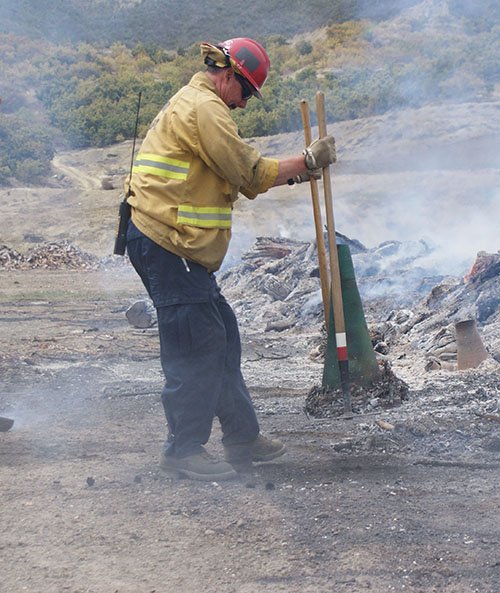Fire-inspired art exhibit at Cal Lutheran
Featured artists teach at CSUCI and Hancock College

The exhibit features hand-built and -thrown ceramic traffic cones that Ventura County firefighters placed in controlled burns.
(THOUSAND OAKS, Calif. – Oct. 4, 2018) An exhibit that highlights the effect of flames on landscapes and cultures will be on display at California Lutheran University from Oct. 19 through Jan. 10.
“Pyrometric: Earth and Ash in the Anthropocene” will be on exhibit in the Kwan Fong Gallery of Art and Culture on the Thousand Oaks campus. Featured artists Amiko Matsuo and Brad Monsma will give a related presentation, “Art and Community in a Vital, Material World,” at 4 p.m. Thursday, Nov. 1, in nearby Richter Hall. A reception in the gallery will follow the presentation.
The project’s genesis dates back to 2013, when Matsuo and Monsma were teaching at California State University, Channel Islands, in Camarillo and the Springs Fire necessitated an evacuation of the campus. Matsuo started thinking about how art could express the ways people respond to nature. When Matsuo and Monsma learned about tsunami stones that mark zones of safety and danger in Japan, they began to think about ways art can mediate between people and nature and how ecological processes become part of making art.
The exhibit, which looks at both the destructive and transformative sides of fire, features ceramics by both artists and two-dimensional works by Matsuo. There are hand-built and -thrown ceramic traffic cones that Ventura County firefighters placed in controlled burns and cones that were fired with a dusting of ash from previous fires. Like pyrometric cones, which are used to gauge heat in kilns, the cones suggest the nature of the fires they experienced. The artists used contemporary and ancient techniques, including a Japanese coil-building method called nejitate.
Matsuo, who now teaches art at Allan Hancock College in Santa Maria, and Monsma, an English professor at CSUCI, worked with locally sourced chaparral and clay, including some from a creek near the Cal Lutheran campus. Materials include native seeds, pinecones and orange fire retardant dropped from helicopters.
“We're all part of everything else, and our efforts as artists intersect with the efforts of the things and processes we work with, including fire,” Monsma said. “Art as personal expression seems inadequate to the future of an overheated planet, so we try to recognize the properties, motivations and ecologies of things themselves as our co-creators, our community.”
Admission to the exhibit and lecture is free.
The Kwan Fong Gallery, located in Soiland Humanities Center, is open to the public from 8 a.m. to 8 p.m. Monday through Saturday. Richter Hall is located in the Ahmanson Science Center. Both buildings are on the south side of Memorial Parkway between Pioneer and Regent avenues. For more information, contact curator Rachel T. Schmid at 805-493-3697 or visit CalLutheran.edu/kwanfong.